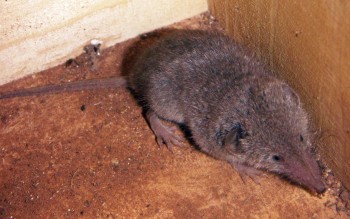Scientific name: Crocidura russula
Family: Soricidae
Appearance: The Greater White-toothed Shrew has the pointed snout characteristic of all shrews. It is very difficult to distinguish from the Lesser White-toothed Shrew - although it is slightly larger. It has a flatter forehead and more prominent ears than the Pygmy Shrew and can also be distinguished from the Pygmy Shrew by the sparse, erect hairs on its tail.
Size: Head and body 4.4-8.6 cm; Tail 2.4-4.7 cm; Weight 5-16 g.
Natural history: The Greater White-toothed Shrew is an introduced species and is present only in Ireland where it is rare. It has been found in farmland that provides grassland, hedgerows and woodland and also around rural settlements. Like all shrews it is carnivorous and feeds on a wide variety of invertebrates and will also take small vertebrates. It is active throughout the year and at all hours of the day. Breeding takes place from February through to October, with females producing several litters each containing between 2 and 10 young.

(C) Bárbol (shared under a CC BY-NC-SA 2.0 license)

 English (United Kingdom)
English (United Kingdom)  Nederlands (nl-NL)
Nederlands (nl-NL)  Magyar
Magyar  Deutsch (Deutschland)
Deutsch (Deutschland)  Croatian (Hrvatski)
Croatian (Hrvatski)  Polski (PL)
Polski (PL)  Español (España)
Español (España)